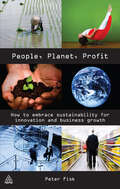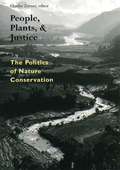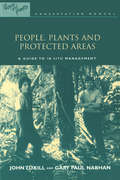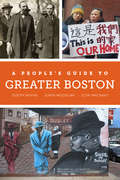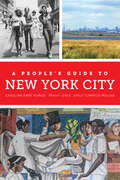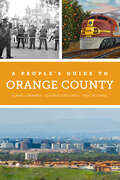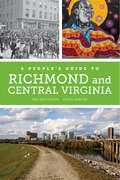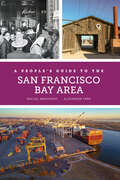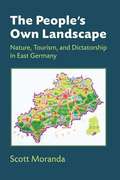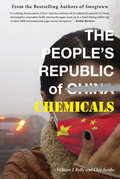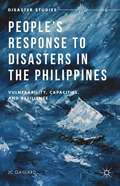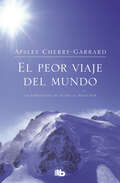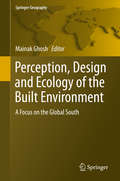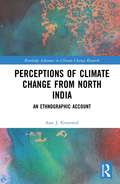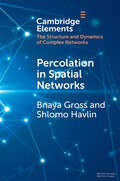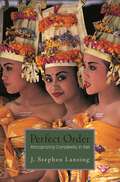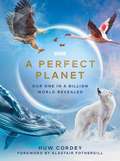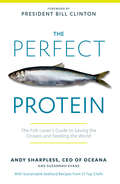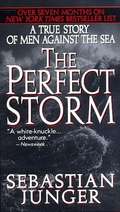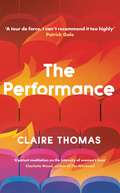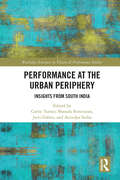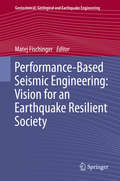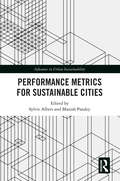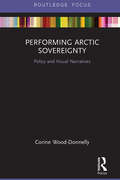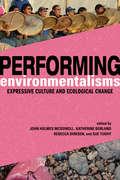- Table View
- List View
People Planet Profit: How to Embrace Sustainability for Innovation and Business Growth
by Peter FiskSocial and environmental issues are more important than ever and consumers are committed to supporting change. 'Doing good' is no longer a peripheral activity but fundamental to every aspect of how we do business, every day, for everyone.People, Planet, Profit is the first book to truly address business growth in the context of social and environmental concerns. It's a practical guide to new business opportunity, operational improvement and competitive advantage. Full of inspiring case studies, it looks at the challenges faced by key players such as Google, Microsoft, Apple, Nokia, Nike, Amazon, M&S and Walmart. With plenty of comments from industry insiders, it's essential reading for CEOs and business managers who are searching for new ways to create value, to make sense of business in a rapidly shifting landscape, and to deliver profitable growth whilst also doing "the right thing".
People, Plants, and Justice: The Politics of Nature Conservation
by Charles ZernerIn an era of market triumphalism, this book probes the social and environmental consequences of market-linked nature conservation schemes. Rather than supporting a new anti-market orthodoxy, Charles Zerner and colleagues assert that there is no universal entity, "the market." Analysis and remedies must be based on broader considerations of history, culture, and geography in order to establish meaningful and lasting changes in policy and practice.Original case studies from Asia, Latin America, Africa, and the South Pacific focus on topics as diverse as ecotourism, bioprospecting, oil extraction, cyanide fishing, timber extraction, and property rights. The cases position concerns about biodiversity conservation and resource management within social justice and legal perspectives, providing new insights for students, scholars, policy professionals and donor/foundations engaged in international conservation and social justice.
People, Plants and Protected Areas: A Guide to in Situ Management (People and Plants International Conservation #Vol. 3)
by Gary Paul Nabhan John Tuxill with Elizabeth Drexler Michael HathawayConservation of plant resources is often focused on seed banks and botanical gardens. However, the two authors of this volume present a comprehensive conservation strategy that complements this ex-situ approach with practical guidance on in-situ management and conservation of plant resources. The book aims to facilitate better management of protected areas and to illustrate new approaches to conservation of plants within their landscapes. It draws on concepts from forestry, the agricultural sciences, anthropology, ethnology and ethnobotany and should be useful to practitioners, academics and policy-makers.
A People's Guide to Greater Boston (A People's Guide Series #2)
by Joseph Nevins Suren Moodliar Eleni MacrakisA People's Guide to Greater Boston reveals the region’s richness and vibrancy in ways that are neglected by traditional area guidebooks and obscured by many tourist destinations. Affirming the hopes, interests, and struggles of individuals and groups on the receiving end of unjust forms of power, the book showcases the ground-level forces shaping the city. Uncovering stories and places central to people’s lives over centuries, this guide takes readers to sites of oppression, resistance, organizing, and transformation in Boston and outlying neighborhoods and municipalities—from Lawrence, Lowell, and Lynn to Concord and Plymouth. It highlights tales of the places and people involved in movements to abolish slavery; to end war and militarism; to achieve Native sovereignty, racial equity, gender justice, and sexual liberation; and to secure workers’ rights. In so doing, this one-of-a-kind guide points the way to a radically democratic Greater Boston, one that sparks social and environmental justice and inclusivity for all.
A People's Guide to New York City (A People's Guide Series #5)
by Carolina Bank Muñoz Penny Lewis Emily Tumpson MolinaThis alternative guidebook for one of the world’s most popular tourist destinations explores all five boroughs to reveal a people’s New York City. The sites and stories of A People’s Guide to New York City shift our perception of what defines New York, placing the passion, determination, defeats, and victories of its people at the core. Delving into the histories of New York's five boroughs, you will encounter enslaved Africans in revolt, women marching for equality, workers on strike, musicians and performers claiming streets for their art, and neighbors organizing against landfills and industrial toxins and in support of affordable housing and public schools. The streetscapes that emerge from these groups' struggles bear the traces, and this book shows you where to look to find them. New York City is a preeminent global city, serving as the headquarters for hundreds of multinational firms and a world-renowned cultural hub for fashion, art, and music. It is among the most multicultural cities in the world and also one of the most segregated cities in the United States. The people that make this global city function—immigrants, people of color, and the working classes—reside largely in the so-called outer boroughs, outside the corporations, neon, and skyscrapers of Manhattan. A People’s Guide to New York City expands the scope and scale of traditional guidebooks, providing an equitable exploration of the diverse communities throughout the city. Through the stories of over 150 sites across the Bronx, Manhattan, Queens, Brooklyn and Staten Island as well as thematic tours and contemporary and archival photographs, a people’s New York emerges, one in which collective struggles for justice and freedom have shaped the very landscape of the city.
A People's Guide to Orange County (A People's Guide Series #4)
by Elaine Lewinnek Gustavo Arellano Thuy Vo DangThe full and fascinating guidebook that Orange County deserves.A People’s Guide to Orange County is an alternative tour guide that documents sites of oppression, resistance, struggle, and transformation in Orange County, California. Orange County is more than the well-known images on orange crate labels, the high-profile amusement parks of Disneyland and Knott’s Berry Farm, or the beaches. It is also a unique site of agricultural and suburban history, political conservatism in a liberal state, and more diversity and discordance than its pop-cultural images show. It is a space of important agricultural labor disputes, segregation and resistance to segregation, privatization and the struggle for public space, politicized religions, Cold War global migrations, vibrant youth cultures, and efforts for environmental justice. Memorably, Ronald Reagan called Orange County the place "where all the good Republicans go to die," but it is also the place where many working-class immigrants have come to live and work in its agricultural, military-industrial, and tourist service economies. Orange County is the fifth-most populous county in America. If it were a city, it would be the nation’s third-largest city; if it were a state, its population would make it larger than twenty-one other states. It attracts 42 million tourists annually. Yet Orange County tends to be a chapter or two squeezed into guidebooks to Los Angeles or Disneyland. Mainstream guidebooks focus on Orange County’s amusement parks and wealthy coastal communities, with side trips to palatial shopping malls. These guides skip over Orange County’s most heterogeneous half—the inland space, where most of its oranges were grown alongside oil derricks that kept the orange groves heated. Existing guidebooks render invisible the diverse people who have labored there. A People’s Guide to Orange County questions who gets to claim Orange County’s image, exposing the extraordinary stories embedded in the ordinary landscape.
A People's Guide to Richmond and Central Virginia (A People's Guide Series #6)
by Melissa Dawn OotenAn expansive guide for resistance and solidarity across this storied region. Richmond and Central Virginia are a historic epicenter of America’s racialized history. This alternative guidebook foregrounds diverse communities in the region who are mobilizing to dismantle oppressive systems and fundamentally transforming the space to live and thrive. Featuring personal reflections from activists, artists, and community leaders, this book eschews colonial monuments and confederate memorials to instead highlight movements, neighborhoods, landmarks, and gathering spaces that shape social justice struggles across the history of this rapidly growing area. The sites, stories, and events featured here reveal how community resistance and resilience remain firmly embedded in the region’s landscape. A People’s Guide to Richmond and Central Virginia counters the narrative that elites make history worth knowing, and sites worth visiting, by demonstrating how ordinary people come together to create more equitable futures.
A People's Guide to the San Francisco Bay Area (A People's Guide Series #3)
by Rachel Brahinsky Alexander TarrAn alternative history and geography of the Bay Area that highlights sites of oppression, resistance, and transformation.A People’s Guide to the San Francisco Bay Area looks beyond the mythologized image of San Francisco to the places where collective struggle has built the region. Countering romanticized commercial narratives about the Bay Area, geographers Rachel Brahinsky and Alexander Tarr highlight the cultural and economic landscape of indigenous resistance to colonial rule, radical interracial and cross-class organizing against housing discrimination and police violence, young people demanding economically and ecologically sustainable futures, and the often-unrecognized labor of farmworkers and everyday people.The book asks who had—and who has—the power to shape the geography of one of the most watched regions in the world. As Silicon Valley's wealth dramatically transforms the look and feel of every corner of the region, like bankers' wealth did in the past, what do we need to remember about the people and places that have made the Bay Area, with its rich political legacies? With over 100 sites that you can visit and learn from, this book demonstrates critical ways of reading the landscape itself for clues to these histories. A useful companion for travelers, educators, or longtime residents, this guide links multicultural streets and lush hills to suburban cul-de-sacs and wetlands, stretching from the North Bay to the South Bay, from the East Bay to San Francisco. Original maps help guide readers, and thematic tours offer starting points for creating your own routes through the region.
The People's Own Landscape: Nature, Tourism, And Dictatorship In East Germany
by Scott MorandaEast Germany’s Socialist Unity Party aimed to placate a public well aware of the higher standards of living enjoyed elsewhere by encouraging them to participate in outdoor activities and take vacations in the countryside. Scott Moranda considers East Germany’s rural landscapes from the perspective of both technical experts (landscape architects, biologists, and physicians) who hoped to dictate how vacationers interacted with nature, and the vacationers themselves, whose outdoor experience shaped their understanding of environmental change. As authorities eliminated traditional tourist and nature conservation organizations, dissident conservationists demanded better protection of natural spaces. At the same time, many East Germans shared their government’s expectations for economic development that had real consequences for the land. By the 1980s, environmentalists saw themselves as outsiders struggling against the state and a public that had embraced mainstream ideas about limitless economic growth and material pleasures.
The People's Republic of Chemicals
by Chip Jacobs William J. KellyMaverick environmental writers William J. Kelly and Chip Jacobs follow up their acclaimed Smogtown with a provocative examination of China's ecological calamity already imperling a warming planet. Toxic smog most people figured was obsolete needlessly kills as many there as the 9/11 attacks every day, while sometimes Grand Canyon-sized drifts of industrial particles aloft on the winds rain down ozone and waterway-poisoning mercury in America. In vivid, gonzo prose blending first-person reportage with exhaustive research and a sense of karma, Kelly and Jacobs describe China's ancient love affair with coal, Bill Clinton's blunders cutting free-trade deals enabling the U.S. to "export" manufacturing emissions to Asia in a shift that pilloried the West's middle class, Communist Party manipulation of eco-statistics, the horror of "Cancer Villages," the deception of the 2008 Beijing Olympics and spellbinding "peasant revolts" against cancer-spreading plants involving thousands in mostly censored melees. Ending with China's monumental coal-bases decried by climatologists as a global warming dagger, The People's Republic of Chemicals names names and stresses humans over bloodless numbers in a classic sure to ruffle feathers as an indictment of money as the real green that not even Al Gore can deny.
People’s Response to Disasters in the Philippines: Vulnerability, Capacities, and Resilience (Disaster Studies)
by Jc GaillardThis book provides a critical perspective on people's response to disasters in the Philippines. It draws upon an array of case studies to discuss people's vulnerability, capacities and resilience in facing a wide range of different hazards.
El peor viaje del mundo: La expedición de Scott al Polo Sur
by Apsley Cherry-GarrardLas memorias de los tres años de expedición del capitán Scott al Polo Sur narradas por Apsley Cherry-Garrard, quien sobrevivió a las extremas y duras condiciones. La exploración polar es la forma más cruel y solitaria imaginable. El explorador británico Apsley Cherry-Garrard nos lo cuenta a través de sus vivencias en la expedición del capitán Scott al Polo Sur (1910- 1913), en la que éste y tres de sus hombres hallaron la muerte. Esa expedición estuvo marcada por el infortunio desde el comienzo, cuando, en una etapa previa, Cherry-Garrard y otros dos hombres, al borde de la congelación y la locura, consideraron entonces la posibilidad de fenecer. El itinerario hacia el Polo, más terrible aún, se vio además ensombrecido por la noticia de que el noruego Roald Amundsen se les había adelantado por solo unas semanas. A partir de las anotaciones que dejó Scott y, sobre todo, de su propia experiencia, Cherry-Garrard reconstruye en este libro aquellos tres años de penalidades y heroísmo.
Perception, Design and Ecology of the Built Environment: A Focus on the Global South (Springer Geography)
by Mainak GhoshThis edited volume is a compilation of the ‘built environment’ in response to many investigations, analyses and sometimes mere observations of the various dialogues and interactions of the built, in context to its ecology, perception and design. The chapters concentrate on various independent issues, integrated as a holistic approach, both in terms of theoretical perspectives and practical approaches, predominantly focusing on the Global South. The book builds fabric knitting into the generic understanding of environment, perception and design encompassing ‘different’ attitudes and inspirations. This book is an important reference to topics concerning urbanism, urban developments and physical growth, and highlights new methodologies and practices. The book presumes an understanding unearthed from various dimensions and again woven back to a common theme, which emerges as the reader reads through.Various international experts of the respective fields working on the Global South contributed their latest research and insights to the different parts of the book. This trans-disciplinary volume appeals to scientists, students and professionals in the fields of architecture, geography, planning, environmental sciences and many more.
Perceptions of Climate Change from North India: An Ethnographic Account (Routledge Advances in Climate Change Research)
by Aase J. KvanneidPerceptions of Climate Change from North India: An Ethnographic Account explores local perceptions of climate change through ethnographic encounters with the men and women who live at the front line of climate change in the lower Himalayas. From data collected over the course of a year in a small village in an eco-sensitive zone in North India, this book presents an ethnographic account of local responses to climate change, resource management and indigenous environmental knowledge. Aase Kvanneid’s observations cast light on the precarious reality of climate change in this region and bring to the fore issues such as access to water, NGO intervention and climate information for farmers. In doing so, she also explores classic topics in the study of rural India including ritual, gender, social hierarchy and political economy. Overall, this book shows how the cause and effect of climate change is perceived by those who have the most to lose and explores how the impact of climate change is being dealt with on a local and global scale. This book will be of great interest to students and scholars of the anthropology of climate change, environmental sociology and rural development.
Percolation in Spatial Networks: Spatial Network Models Beyond Nearest Neighbours Structures (Elements in Structure and Dynamics of Complex Networks)
by Bnaya Gross Shlomo HavlinPercolation theory is a well studied process utilized by networks theory to understand the resilience of networks under random or targeted attacks. Despite their importance, spatial networks have been less studied under the percolation process compared to the extensively studied non-spatial networks. In this Element, the authors will discuss the developments and challenges in the study of percolation in spatial networks ranging from the classical nearest neighbors lattice structures, through more generalized spatial structures such as networks with a distribution of edge lengths or community structure, and up to spatial networks of networks.
Perfect Order: Recognizing Complexity in Bali (Princeton Studies in Complexity #11)
by J. Stephen LansingAlong rivers in Bali, small groups of farmers meet regularly in water temples to manage their irrigation systems. They have done so for a thousand years. Over the centuries, water temple networks have expanded to manage the ecology of rice terraces at the scale of whole watersheds. Although each group focuses on its own problems, a global solution nonetheless emerges that optimizes irrigation flows for everyone. Did someone have to design Bali's water temple networks, or could they have emerged from a self-organizing process? Perfect Order--a groundbreaking work at the nexus of conservation, complexity theory, and anthropology--describes a series of fieldwork projects triggered by this question, ranging from the archaeology of the water temples to their ecological functions and their place in Balinese cosmology. Stephen Lansing shows that the temple networks are fragile, vulnerable to the cross-currents produced by competition among male descent groups. But the feminine rites of water temples mirror the farmers' awareness that when they act in unison, small miracles of order occur regularly, as the jewel-like perfection of the rice terraces produces general prosperity. Much of this is barely visible from within the horizons of Western social theory. The fruit of a decade of multidisciplinary research, this absorbing book shows that even as researchers probe the foundations of cooperation in the water temple networks, the very existence of the traditional farming techniques they represent is threatened by large-scale development projects.
A Perfect Planet
by Huw CordeyThere is no place like home.The conditions of Earth are not just good for life, they are perfect. Everything about our planet - its size, its distance from the Sun, its spin and tilt, its moon - is perfectly suited to our existence, and our planet's forces serve to nurture its spectacular biodiversity. A Perfect Planet shows in stunning detail how Earth has always been more than the sum of its parts. Unlike any other astronomical body, it is a living world.Focusing on four key natural forces - global weather systems distributing fresh water to all corners; marine currents delivering nutrients to the deepest reaches of the ocean; solar energy warming and electrifying everything it touches; and volcanic activity fertilising the earth's surface - Huw Cordey reveals to us new levels of this living world, a place populated with astonishing characters living remarkable lives. From Arctic wolves prowling moonlit landscapes or wood frogs, frozen in winter and magically thawing back to life, to flamingos flying thousands of miles to a vast volcanic lake in Africa to breed, we see time and again how animals are perfectly adapted to whatever the environment throws at them.Packed with over 250 full-colour images, and including a foreword by Alastair Fothergill and stills from the BBC series' spectacular footage, A Perfect Planet is a stunning exploration of life on Earth - life that is increasingly precious and rare.
The Perfect Protein: The Fish Lover's Guide to Saving the Oceans and Feeding the World
by Andy Sharpless Suzannah EvansThe planet will be home to more than 9 billion people by 2050, and we're already seeing critical levels of famine around the world mirrored by growing obesity in developed nations. In The Perfect Protein, Andy Sharpless maintains that protecting wild seafood can help combat both issues, because seafood is the healthiest, cheapest, most environmentally friendly source of protein on earth. While the conservation community has taken a simplistic, save-the-whales approach when it comes to oceans, Sharpless contends that we must save the world's seafood not just to protect marine life and biodiversity but to stave off the coming humanitarian crisis. With high demand for predator species like tuna and salmon, wealthy nations like the U.S. convert "reduction" species such as anchovies, mackerel, and sardines into feed for salmon and other farmed animals—even though these overlooked fish are packed with health-boosting Omega-3 fatty acids and could feed millions. By establishing science-based quotas, protecting wild habitats, and reducing bycatch (and treating anchovies and their like as food, not feed), Sharpless believes that effective ocean stewardship can put healthy, sustainable seafood on the table forever. To that end, Oceana has tapped 20-plus chefs, including Mario Batali, Eric Ripert, and Jose Andres for recipes that give us all a role to play in this revolutionary mission: to save the fish so that we can eat more fish.
The Perfect Storm: A True Story of Men Against the Sea
by Sebastian JungerThe bestselling book that became the blockbuster film starring George Clooney, Mark Wahlberg, and Diane Lane.<P> In October 1991, three weather systems collided off the coast of Nova Scotia to create a storm of singular fury, boasting waves over one hundred feet high. Among its victims was the Gloucester, Massachusetts-based swordfishing boat the Andrea Gail, which vanished with all six crew members aboard.<P> "Drifting down on swimmers is standard rescue procedure, but the seas are so violent that Buschor keeps getting flung out of reach. There are times when he's thirty feet higher than the men trying to rescue him. . . . [I]f the boat's not going to Buschor, Buschor's going to have to go to it. SWIM! they scream over the rail. SWIM! Buschor rips off his gloves and hood and starts swimming for his life."<P> It was the storm of the century, boasting waves over one hundred feet high a tempest created by so rare a combination of factors that meteorologists deemed it "the perfect storm." When it struck in October 1991, there was virtually no warning. "She's comin' on, boys, and she's comin' on strong," radioed Captain Billy Tyne of the Andrea Gail off the coast of Nova Scotia, and soon afterward the boat and its crew of six disappeared without a trace. <P> In a book taut with the fury of the elements, Sebastian Junger takes us deep into the heart of the storm, depicting with vivid detail the courage, terror, and awe that surface in such a gale. Junger illuminates a world of swordfishermen consumed by the dangerous but lucrative trade of offshore fishing, "a young man's game, a single man's game," and gives us a glimpse of their lives in the tough fishing port of Gloucester, Massachusetts; he recreates the last moments of the Andrea Gail crew and recounts the daring high-seas rescues that made heroes of some and victims of others; and he weaves together the history of the fishing industry, the science of storms, and the candid accounts of the people whose lives the storm touched, to produce a rich and informed narrative. The Perfect Storm is a real-life thriller that will leave readers with the taste of salt air on their tongues and a sense of terror of the deep.
The Performance: A Novel
by Claire Thomas'Quietly transformational'The Times 'A tour de force... I can't recommend this too highly'Patrick Gale'Innovative... an original, at-a-sitting read'Daily Mail'A potent meditation on the intensity of women's lives'Charlotte Wood, author of The Weekend'A miracle... Engaging and evocative'Washington Post'I loved and admired The Performance... Unmissable'Emma Stonex, author of The Lamplighters'Lively and intimate... The way Thomas plays with the reader is a sort of genius'Guardian'Thomas writes these women with such wisdom and compassion, that by the end we are all transformed'Claire Fuller, author of Unsettled Ground The false cold of the theatre makes it hard to imagine the heavy wind outside in the real world, the ash air pressing onto the city from the nearby hills where bushfires are taking hold.The house lights lower.The auditorium feels hopeful in the darkness.As bushfires rage outside the city, three women watch a performance of a Beckett play.Margot is a successful professor, preoccupied by her fraught relationship with her ailing husband. Ivy is a philanthropist with a troubled past, distracted by the snoring man beside her. Summer is a young theatre usher, anxious about the safety of her girlfriend in the fire zone.As the performance unfolds, so does each woman's story. By the time the curtain falls, they will all have a new understanding of the world beyond the stage.
Performance at the Urban Periphery: Insights from South India (Routledge Advances in Theatre & Performance Studies)
by Anindya Sinha Cathy Turner Jerri Daboo Sharada SrinivasanThis edited volume considers performance in its engagement with expanding Indian cities, with a particular focus on festivals and performances in Karnataka, Tamil Nadu and Kerala. The editors ask how performance practices are affected by urbanisation, the effects of such changes on their cultural economy, and the environmental impacts of performance itself. This project also considers how performance responds to its context, and the potential for performance to be critical of the city’s development, and of its own compromises. Bringing together perspectives from the humanities, natural and social sciences, the book takes a multi-faceted analytical view of live performance, connecting contemporary with heritage forms, and human with more-than-human actors. The three sections, themed around heritage, everyday life, and future ecologies, will be of great interest to students and scholars in performance, heritage studies, ecology and art history.
Performance-Based Seismic Engineering: Vision for an Earthquake Resilient Society
by Matej FischingerThe Bled workshops have traditionally produced reference documents providing visions for the future development of earthquake engineering as foreseen by leading researchers in the field. The participants of the 2011 workshop built on the tradition of these events initiated by Professors Fajfar and Krawinkler to honor their important research contributions and have now produced a book providing answers to crucial questions in today's earthquake engineering: "What visible changes in the design practice have been brought about by performance-based seismic engineering? What are the critical needs for future advances? What actions should be taken to respond to those needs?" The key answer is that research interests should go beyond the narrow technical aspects and that the seismic resilience of society as a whole should become an essential part of the planning and design process. The book aims to provide essential guidelines for researchers, professionals and students in the field of earthquake engineering. It will also be of particular interest for all those working at insurance companies, governmental, civil protection and emergency management agencies that are responsible for assessing and planning community resilience. The introductory chapter of the book is based on the keynote presentation given at the workshop by the late Professor Helmut Krawinkler. As such, the book includes Helmut's last and priceless address to the engineering community, together with his vision and advice for the future development of performance-based design, earthquake engineering and seismic risk management.
Performance Metrics for Sustainable Cities (Advances in Urban Sustainability)
by SylvieManish Albert PandeyPerformance Metrics for Sustainable Cities provides an overview of measurement systems and tools to enable communities to self-assess and benchmark their progress along a continuum of smart, intelligent, and sustainable development. It begins by explaining the importance of measurement and evaluation for cities and smaller communities, as well as future factors that will need to be considered and embedded into planning processes. Across 14 chapters, the book describes existing evaluation mechanisms that are being used for government funding decisions, awards of recognition, and new measurement systems to assess what makes a city smarter and more sustainable, such as broader sustainable goal targets (UN SDGs), green cities, fabrication cities, and compassionate cities. It presents examples of metrics used for important sustainability and liveability concepts for cities such as how to measure trust, engagement, compassion, circular economy, and so forth. The book ends with reflections on the feasibility of a holistic system of measurement and the implications of its implementation. This volume will be of great interest to students, researchers, and professionals of urban sustainability, planning, smart cities, and sustainable communities.
Performing Arctic Sovereignty: Policy and Visual Narratives (Routledge Research in Polar Regions)
by Corine Wood-DonnellyThe Arctic is 5.5 million square miles and has been inhabited by humans for thousands of years, yet it is still a frontier of development. But who owns the Arctic? This book charts the history of performances of sovereignty over the Arctic in the policy and visual representations of the US, Canada and Russia. Focusing on narratives of the effective occupation of territory found in postage stamps, it offers a novel analysis of Arctic sovereignty. Issues such as climate change, plastics pollution and resource development continue to impact the future of this space centred around the North Pole. Who is responsible for the region? This book examines how countries have absorbed Arctic territory into their national consciousness, examining the choice of, and use of, symbols and images in postage stamps. It looks at the story of how these countries have represented their Arctic frontiers and territorial peripheries. The book argues that the performance of policy in these regions has caused relative sovereignty to become a reality. It provides an intriguing account of how these countries have, in their distinctive ways, established, legitimised and reinforced their political authority in these regions. This book will appeal to Geographers and is recommended supplementary reading for students in political history and regional studies of the North.
Performing Environmentalisms: Expressive Culture and Ecological Change
by Aaron S. Allen Eduardo S Brondizio Assefa Tefera Dibaba Rebecca Dirksen Mary Hufford John Holmes McDowell Mark Pedelty Jennifer C. Post Chie Sakakibara Jeff Todd Titon Rory Turner Lois WilckenPerforming Environmentalisms examines the existential challenge of the twenty-first century: improving the prospects for maintaining life on our planet. The contributors focus on the strategic use of traditional artistic expression--storytelling and songs, crafted objects, and ceremonies and rituals--performed during the social turmoil provoked by environmental degradation and ecological collapse. Highlighting alternative visions of what it means to be human, the authors place performance at the center of people's responses to the crises. Such expression reinforces the agency of human beings as they work, independently and together, to address ecological dilemmas. The essays add these people's critical perspectives--gained through intimate struggle with life-altering force--to the global dialogue surrounding humanity's response to climate change, threats to biocultural diversity, and environmental catastrophe. Interdisciplinary in approach and wide-ranging in scope, Performing Environmentalisms is an engaging look at the merger of cultural expression and environmental action on the front lines of today's global emergency. Contributors: Aaron S. Allen, Eduardo S. Brondizio, Assefa Tefera Dibaba, Rebecca Dirksen, Mary Hufford, John Holmes McDowell, Mark Pedelty, Jennifer C. Post, Chie Sakakibara, Jeff Todd Titon, Rory Turner, Lois Wilcken
